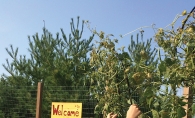
Karin Costa of Costa Produce Farm & Greenhouse offers up some sage advice on creating those beautiful patio pots, from veggie- and herb-filled dandies to bloom- and blossom-filled beauties.
“Within the last 10 years or so, people have gotten back into their own vegetable growing, herb pots and cooking with what is local,” says Costa.
And patio pots are an easy way to make the jump to homegrown goodness. Small variety tomato plants and a wide range of peppers thrive in large patio pots. “Many people also include herbs, which are great for the pollinators, too,” Costa notes.
“I would recommend you don’t go any smaller than a 14-inch pot, and at least that deep,” she says. Larger pots are always better, Costa explains, and a little more forgiving if you miss a day of watering here and there.
Parsley and mint are pretty prolific, and one to two plants should last you the summer. “Sage and rosemary are also very easy to grow,” says Costa. “They’re slower growers, but they’re probably not as widely used either, so one to two plants would be enough for most families for the summer as well.”
For the intrepid gardener, there are also the more finicky basil and oregano. They prefer a dry, hot summer (and seven or more hours of sunshine a day), so plan on sticking them in their own pots; that way, you can tuck them under the eaves or in the garage on rainy days.
Just because they’re useful doesn’t mean herbs can’t be ornamental, too. Parsley makes a great filler, Costa notes, while a mint plant draped down the side is a creative spiller. “As far as in a pot, there’s the old standard of planting where you do a filler, a thriller and a spiller,” Costa explains.
Thrillers go in the middle and add a little height to the arrangement. Grasses like purple fountain or King Tut are popular choices for a dramatic effect, says Costa.
For fillers, look for mid-sized plants with a splash of color. Angelonias are popular, and geraniums have staged a comeback. “They’re very hardy,” says Costa, “and you get a huge bloom of color with a geranium.”
For that spiller, look for something you can trail over the edge of the pot. “There are all kinds of different vines—German ivy, vinca vines, things like that,” Costa says.









